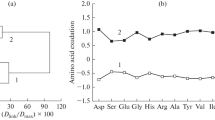Abstract
The conversion of synthetic root exudates, i.e. of a mixture of amino acids, organic acids and sugars, added to soil in a single dose or continuously, was studied. After the addition of a single dose, the root exudates were gradually mineralized and after 76 hours, 85% of carbon had been released in the form of carbon dioxide. The extent and rate of mineralization was not influenced by the simultaneous addition of ammonium phosphate. The continuous addition of substrate formed a model artificial rhizosphere. In the steady state, 93% of the carbon in the added substrate was mineralized to carbon dioxide. The conversion of organic acids, sugars and amino acids and the mineralization of nitrogen was studied simultaneously by chromatography. In soil continuously enriched with root exudates, phenomena similar to the rhizosphere effect in nature were observed both in the numbers of microorganisms and in the relative incidence of the nutritional groups of bacteria.
Similar content being viewed by others
References
Bremner, J. M., Shaw, K.:Denitrification of soil. I. Methods of investigation. J. agr. Sci. 51:22, 1958.
Drobník, J.:A respirometric study of glucose metabolism in soil samples. Fol. biol. (Praha) 4: 137, 1958.
Drobník, J.:A Warburg vessel for soil samples. Nature 188: 686, 1960a.
Drobník, J.:Primary oxidation of organic matter in the soil. I. The form of respiration curves with glucose as the substrate. Plant & Soil 12: 199. 1960b.
Drobník, J.:Primary oxidation of some organic compounds in remoistened air-dried soil. Can. J. Microbiol. 7: 769, 1961.
Lees, H., Quastel, J. H.:Biochemistry of nitrification in soil I. Kinetics of, and the effects of poisons on, soil nitrification, as studied by a soil perfusion technique. Addendum by H. Lees: A soil perfusion apparatus. Biochem. J. 40: 803, 1946.
Macura, J.:Seed and soil bacteria in relation to the rhizosphere effect. Fol. biol. (Praha) 4: 274, 1958.
Maoura, J.:Continuous flow method in soil microbiology. I. Apparatus. Fol. microbiol. 6: 328, 1961.
Macura, J.:Interrelations between microorganisms and plant in the rhizosphere. Plant Microbes Relationships. Proc. Symp. on Relationships between Soil Microorganisms and Plant Roots, p. 26. Publ. House Czechoslov. Acad. Sci., Prague, 1965.
Macura, J., Kunc, F.:Continuous flow method in soil microbiology. II. Observations on glucose metabolism. Fol. microbiol. 6: 398, 1961.
Me Garity, J. W., Gilmour, C. M., Bollen, W. B.:Use of an electrolytic respirometer to study denitrification in soil. Can. J. Microbiol. 4: 303, 1958.
Najmr, S., Cikánek, M.:Simultaneous determination of carbon and nitrogen in soil. (In Czech). Sborník ČSAZV A. 26: 285, 1953.
Novák B., Nováková, J.:The effect of organic materials on physical, chemical and microbiological changes of soil with particular regard to humus formation. (In Czech). Rostlinná výroba. 6: 1399, 1960.
Rivière, J.:Etude de la rhizosphère du blé. Ann. Agronomique 11: 397, 1960.
Rovira, A. D.:Plant root excretions in relation to the rhizosphere effect. II. A study of the properties of root exudates, its effect on the growth of microorganisms isolated from the rhizosphere and control soil. Plant & Soil, 7: 195, 1956.
Schmidt, E. L., Putnam, H. D., Paul, E. A.:Behaviour of amino acids in soil. Bacteriol. Proc. p. 11, 1957.
Sasson, A., Kunc, F.:Sur l’activité biologique de sols arides du Maroc. Bulletin de la Société des Sciences Naturelles et Physiques du Maroc, 1er et 2me trimestres. 55, 1963.
Smith, N. R., Dawson, V. T.:The bacteriostatic action of bengal rose in media used for plate counts of soil fungi. Soil Sci. 58: 467, 1944.
Stotzky, G.:A simple method for the determination of the respiratory quotient of soils. Can. J. Microbiol. 6: 439, 1960.
Stotzky, G., Norman, A. G.:Factors limiting microbial activities in soil. I. The level of substrate, nitrogen and phosphorus. Arch. Mikrobiol. 40: 341, 1961.
Taylor, C. B.:The nutritional requirements of predominant flora of the soil. Proc. Soc. appl. Bact. 14:: 101, 1951.
Timonin, M. J.:The interaction of higher plants and soil microorganisms. III. Effect of by-products of plant growth on activity of fungi and actinomycetes. Soil Sci. 52: 395, 1941.
Vancura, V.:Root exudates of plants. I. Analysis of root exudates of barley and wheat in their initial phases of growth. Plant & Soil 21: 231, 1964.
Author information
Authors and Affiliations
Rights and permissions
About this article
Cite this article
Kunc, F., Macura, J. Decomposition of root exudates in soil. Folia Microbiol 11, 239–247 (1966). https://doi.org/10.1007/BF02878892
Received:
Issue Date:
DOI: https://doi.org/10.1007/BF02878892




